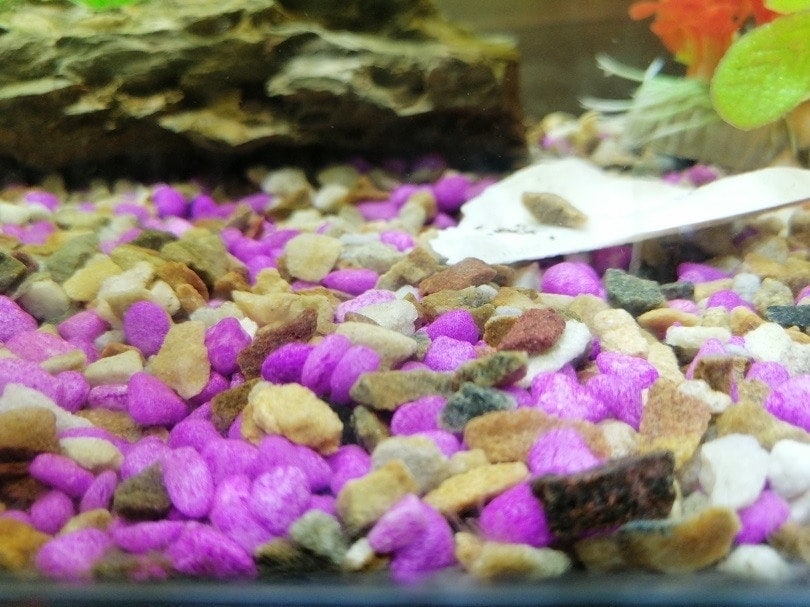Detritus Worms: What Are They & How to Get Rid of Them

Updated on

You may find yourself peering into your aquarium, only to be appalled by a colony of thin white worms. Although detritus worms are unappealing, they are not all bad. They may look unsightly, but they are NOT harmful to live fish or invertebrates.
These tiny worms are common in most aquarium environments and are usually found in large clustering groups. Most of the time, a few detritus worms are present in your aquarium’s substrate. They are not always visible until they start to reproduce when the environment is suitable.
Where You’ll See Detritus Worms
Detritus worms commonly sit on the walls of the tank, behind aquarium suction cups (like those from a stick-on thermometer), and even underneath gravel or sand. Luckily, they are easy to keep under control. Getting rid of detritus worms does not call for a chemical additive depending on the severity. In some cases, your fish will happily snack on them. It may be helpful, but your fish will not be able to control a rising population for long.
In this article, we put together some simple methods to get rid of detritus worms, while informing you how to keep the colony under control.
What Are Detritus Worms?
Detritus worms are small, thread-like aquatic worms that consume decomposing organic waste in an aquarium. They are detritivores part of the annelid phylum. Detritus worms resemble a white to light brown color with a needlepoint head.
Their diet in an aquarium primarily involves the worms feeding off your inhabitant’s waste and uneaten food leftover in the tank. It makes them beneficial to your aquarium as they are helping to breakdown the bioload in the aquarium.
Detritus worms move around the tank by crawling across the glass and between the substrate. You will notice the worms catching a ride in the aquariums current to get to new areas. You may see them using a zigzag pattern to support themselves in the water.
Determining Why Detritus Worms Are in Your Aquarium
There can be a few factors why detritus worms have decided to accumulate in your aquarium. Most of the time the worms are introduced into your aquarium via a new live plant or fish.
- The aquarium is not filtered appropriately
- Low oxygen levels make the worm leave the substrate to obtain more oxygen.
- Dirty/clouded water
- Poor water changing schedule
- Polluted substrate
- High bio-load in the aquarium
- Decomposing leftover food
- Decomposing fish or invertebrate body
- Gravel vacuum – Use an aquarium gravel vacuum to suck up the worms and any waste out of the substrate. Doing this ensures you are removing the worms at a faster rate than they can reproduce. It is a method used by many aquarists to keep these worms under control long-term.
- Feed sparingly – Do not overfeed your fish. Keep to a strict feeding schedule and only feed enough as necessary. Use a net to catch any leftover food floating around. It prevents the food from ending up in the substrate where detritus worms will eat and rapidly reproduce on the decomposing waste.
- Filtration – Use a strong filter that can filter five times the amount of water in your tank. It will keep the tank clean and can suck up the worms in the water column. A sponge filter with a good intake pull works best.
- Fish that eat detritus worms – Add fish to your aquarium that will readily eat these worms. These fish include goldfish, tetras, mollies, or loaches. It offers them a source of protein. It does not mean the fish can reduce the number of detritus worms, but rather keep the population down.
- Water changes – Changing the aquarium water regularly ensures you are keeping the water clean while removing any accumulated debris out of the water.
- Plant maintenance – Regularly maintain your aquarium plants. Leaving the plants to die off and decompose will result in a rapid population of these uninvited guests. Cut off dying leaves and roots.
- Hydrogen peroxide – Use a diluted mix of hydrogen peroxide in severe cases. It is safe in very low doses to some plants. Note: it is potentially HARMFUL to some inhabitants. Remove them to a separate tank for a few days while the peroxide kills off the pests. Do a thorough water change after and rinse off items in the aquarium in old tank water to remove residue.
Final Thoughts
Keeping your aquarium clean alongside regular gravel vacuums will kill off and remove detritus worms naturally. Aquarium deformers and hydrogen peroxide should be used with caution and only in severe infestations. Detritus worms are an indication that an aquarium is in good health so do not be alarmed when you notice a few throughout your tank. With a good balance in your aquarium, you will be able to keep your aquarium free of detritus worms.
See Also:












